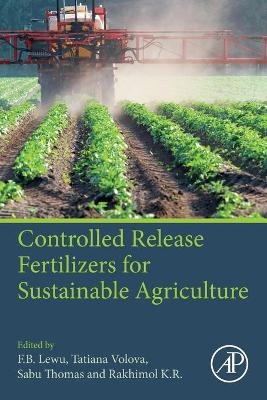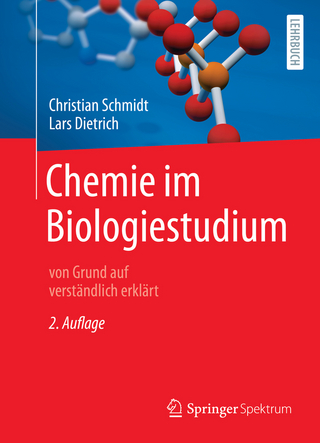
Controlled Release Fertilizers for Sustainable Agriculture
Academic Press Inc (Verlag)
978-0-12-819555-0 (ISBN)
Conventional release mechanisms have historically meant waste of fertilizers and the adverse effects of that waste on the environment. Controlled release delivery makes significant strides in enhancing fertilizer benefit to the target plant, while protecting the surrounding environment and increasing sustainability.
F.b. Lewu received his PhD in Botany with specialization in plant genetic conservation and propagation. Joining the Department of Agriculture, University of Zululand, South Africa as a Lecturer in 2008 he was appointed acting HOD, of the department in 2009; a position he held till end of May 2011, when he joined the Cape Peninsula University of Technology as HOD of Agriculture Department in the Faculty of Applied Sciences in 2011. Appointed Associate Professor in 2014 and obtaining C Rating of National Research Foundation (NRF C3 Rated Scholar) of South Africa during the same year, he is a qualified Professional Natural Scientist. His latest research interest is focused on the influence of nanomaterials and chemical elicitors on the efficacy of medicinal species and their ameliorating effects on biochemicals of screened materials through different propagation and screening methods. Tatiana Volova is a doctor of biological sciences in microbiology, Professor and head of the Department of Biotechnology at the Siberian Federal University. She is the creator and head of the Laboratory of Chemoautotrophic Biosynthesis in the Institute of Biophysics, Siberian Branch of Russian Academy of Sciences. Professor Volova is conducting research in the field of physic-chemical biology and biotechnology and a well-known expert in the field of microbial physiology and biotechnology. Tatiana Volova has created and developed a new and original branch in chemoautotrophic biosynthesis, in which the two main directions of the XXI century technologies are conjugate, hydrogen energy and biotechnology. Tatiana Volova is the author of more than 300 scientific works, including 12 monographs, 16 inventions, and a series of textbooks for universities. Prof. Sabu Thomas is a Professor of Polymer Science and Engineering and the Director of the School of Energy Materials at Mahatma Gandhi University, India. Additionally, he is the Chairman of the Trivandrum Engineering Science & Technology Research Park (TrEST Research Park) in Thiruvananthapuram, India. He is the founder director of the International and Inter-university Centre for Nanoscience and Nanotechnology at Mahatma Gandhi University and the former Vice-Chancellor of the same institution. Prof. Thomas is internationally recognized for his contributions to polymer science and engineering, with his research interests encompassing polymer nanocomposites, elastomers, polymer blends, interpenetrating polymer networks, polymer membranes, green composites, nanocomposites, nanomedicine, and green nanotechnology. His groundbreaking inventions in polymer nanocomposites, polymer blends, green bionanotechnology, and nano-biomedical sciences have significantly advanced the development of new materials for the automotive, space, housing, and biomedical fields. Dr. Thomas has been conferred with Honoris Causa (DSc) by the University of South Brittany, France. Rakhimol R.K. is a researcher in International and Inter University Centre for Nanoscience and Nanotechnology, Mahatma Gandhi University, Kottayam, Kerala, India. She has received a bachelor’s degree in Biotechnology from Mahatma Gandhi University, Kottayam, Kerala, India, master’s degree in Biotechnology from Mahatma Gandhi University, Kottayam, Kerala, India and MPhil degree in Nanoscience and Nanotechnology from Mahatma Gandhi University, Kottayam, Kerala, India. Now, Rakhimol is doing her PhD work at International and Inter university Centre for Nanoscience and Nanotechnology, Mahatma Gandhi University, Kottayam, Kerala, India. She is currently pursuing her research on nanoparticles and their effect on plants.
1. Controlled Release of Fertilizers for Sustainable Agriculture: State of the art, opportunities and novelty
2. Conventional methods for fertilizer release
3. Fate of the conventional fertilizers in environment
4. Controlled release of fertilizers- concept, reality and mechanism
5. Controlled and slow release fertilizers
6. Characteristics and types of slow- and controlled-release fertilizers
7. Methods for controlled release of fertilizers
8. Manufacturing of slow- and controlled-release Fertilizers
9. Factors controlling the release of fertilizers, Advantages and disadvantages of slow- and controlled-release fertilizers
10. Options for the application of slow- and controlled-release fertilizers, Consumption and economics of slow- and controlled-release of fertilizers
11. Costs and benefits of slow- and controlled-release fertilizers, Sensors detecting controlled fertilizer release
12. Trends and technologies behind controlled release fertilizers
13. Nanotechnology in controlled release fertilizers
14. Polymer formulations for controlled release of fertilizers
15. Chemistry and toxicology behind chemical fertilizers, Theory and simulation modelling of controlled release of fertilizers
16. Controlled release of organic fertilizers, Future of controlled release fertilizers
| Erscheinungsdatum | 23.10.2020 |
|---|---|
| Verlagsort | San Diego |
| Sprache | englisch |
| Maße | 152 x 229 mm |
| Gewicht | 430 g |
| Themenwelt | Naturwissenschaften ► Biologie ► Biochemie |
| Naturwissenschaften ► Biologie ► Mikrobiologie / Immunologie | |
| Weitere Fachgebiete ► Land- / Forstwirtschaft / Fischerei | |
| ISBN-10 | 0-12-819555-X / 012819555X |
| ISBN-13 | 978-0-12-819555-0 / 9780128195550 |
| Zustand | Neuware |
| Haben Sie eine Frage zum Produkt? |
aus dem Bereich


